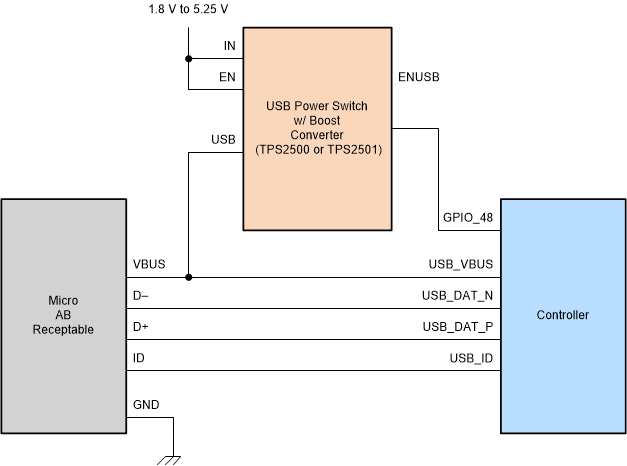JAJSU19 April 2024 DLPC7530
PRODUCTION DATA
- 1
- 1 特長
- 2 アプリケーション
- 3 概要
- 4 Pin Configuration and Functions
-
5 Specifications
- 5.1 Absolute Maximum Ratings
- 5.2 ESD Ratings
- 5.3 Recommended Operating Conditions
- 5.4 Thermal Information
- 5.5 Power Electrical Characteristics
- 5.6 Pin Electrical Characteristics
- 5.7 DMD HSSI Electrical Characteristics
- 5.8 DMD Low-Speed LVDS Electrical Characteristics
- 5.9 V-by-One Interface Electrical Characteristics
- 5.10 FPD-Link LVDS Electrical Characteristics
- 5.11 USB Electrical Characteristics
- 5.12 System Oscillator Timing Requirements
- 5.13 Power Supply and Reset Timing Requirements
- 5.14 DMD HSSI Timing Requirements
- 5.15 DMD Low-Speed LVDS Timing Requirements
- 5.16 V-by-One Interface General Timing Requirements
- 5.17 FPD-Link Interface General Timing Requirements
- 5.18 Parallel Interface General Timing Requirements
- 5.19 Source Frame Timing Requirements
- 5.20 Synchronous Serial Port Interface Timing Requirements
- 5.21 Controller and Target I2C Interface Timing Requirements
- 5.22 Programmable Output Clock Timing Requirements
- 5.23 JTAG Boundary Scan Interface Timing Requirements (Debug Only)
- 5.24 JTAG ARM Multi-Ice Interface Timing Requirements (Debug Only)
- 5.25 Multi-Trace ETM Interface Timing Requirements
- 6 Detailed Description
- 7 Application and Implementation
- 8 Power Supply Recommendations
-
9 Layout
- 9.1
Layout Guidelines
- 9.1.1 General Layout Guidelines
- 9.1.2 Power Supply Layout Guidelines
- 9.1.3 Layout Guidelines for Internal Controller PLL Power
- 9.1.4 Layout Guideline for DLPC7530 Reference Clock
- 9.1.5 V-by-One Interface Layout Considerations
- 9.1.6 FPD-Link Interface Layout Considerations
- 9.1.7 USB Interface Layout Considerations
- 9.1.8 DMD Interface Layout Considerations
- 9.1.9 General Handling Guidelines for Unused CMOS-Type Pins
- 9.1.10 Maximum Pin-to-Pin, PCB Interconnects Etch Lengths
- 9.2 Thermal Considerations
- 9.1
Layout Guidelines
- 10Device and Documentation Support
- 11Revision History
- 12Mechanical, Packaging, and Orderable Information
5.11 USB Electrical Characteristics
Over operating free-air temperature range (unless otherwise noted)
| PARAMETER(1)(2) | MIN | NOM | MAX | UNIT | ||
|---|---|---|---|---|---|---|
| Low Speed and Full Speed (Input Level) | ||||||
| VIH | Single-ended input voltage high (driven) | 2.0 | V | |||
| VIHZ | Single-ended input voltage high (floating) | 2.7 | 3.6 | V | ||
| VIL | Single-ended input voltage low | 0.8 | V | |||
| VDI | Differential input sensitivity | |(DP) – (DM)| | 0.2 | V | ||
| VCM | Differential common mode voltage | Includes VDI range | 0.8 | 2.5 | V | |
| Low-Speed and Full Speed (Output Level) | ||||||
| VOL | Low-level output voltage | with 1.425KΩ pullup to 3.6V | 0.0 | 0.3 | V | |
| VOH | High-level output voltage | with 14.25KΩ pulldown | 2.8 | 3.6 | V | |
| VCRS | Output signal crossover voltage | 1.3 | 2.0 | V | ||
| High-Speed (Input Level) | ||||||
| VHSSQ | High-speed squelch detection threshold (differential signal amplitude) | 100 | 150 | mV | ||
| VHSDSC | High-speed disconnect detection threshold (differential signal amplitude) | 525 | 626 | mV | ||
| VHSCM | High-speed data signal common mode voltage | –50 | 500 | mV | ||
| High-Speed (Output Level) | ||||||
| VHSOI | High-speed idle level | –10.0 | 10.0 | mV | ||
| VHSOH | High-speed data signal - high | 360 | 440 | mV | ||
| VHSOL | High-speed data signal - low | –10.0 | 10.0 | mV | ||
| VCHIRPJ | High-speed chirp J level (differential voltage) | 700 | 1100 | mV | ||
| VCHIRPK | High-speed chirp K level (differential voltage) | –900 | –500 | mV | ||
| Termination | ||||||
| RPU | Bus pullup resistor | 1.425 | 1.575 | KΩ | ||
| RPD | Bus pulldown resistor | 14.25 | 15.75 | KΩ | ||
| ZHSDRV | High-speed driver output impedance | 40.5 | 49.5 | Ω | ||
(1) Referenced to VAD33_USB (I/O type 11)
(2) When used as a controller as part of USB OTG, the DLPC7530 requires
an external USB switch to provide the USB
5V
power. The example shown in Figure 5-3 uses a TI TPS2500/2501 device. The example figure does not describe the
required ancillary components (such as resistors and capacitors). For this
information, refer to the USB switch logic data sheet for the selected device.
The external USB switch is not required for product configurations that support
USB
peripheral
mode only.
 Figure 5-3 External USB Switch Example for DLPC7530 Controller as USB OTG Controller
Figure 5-3 External USB Switch Example for DLPC7530 Controller as USB OTG Controller